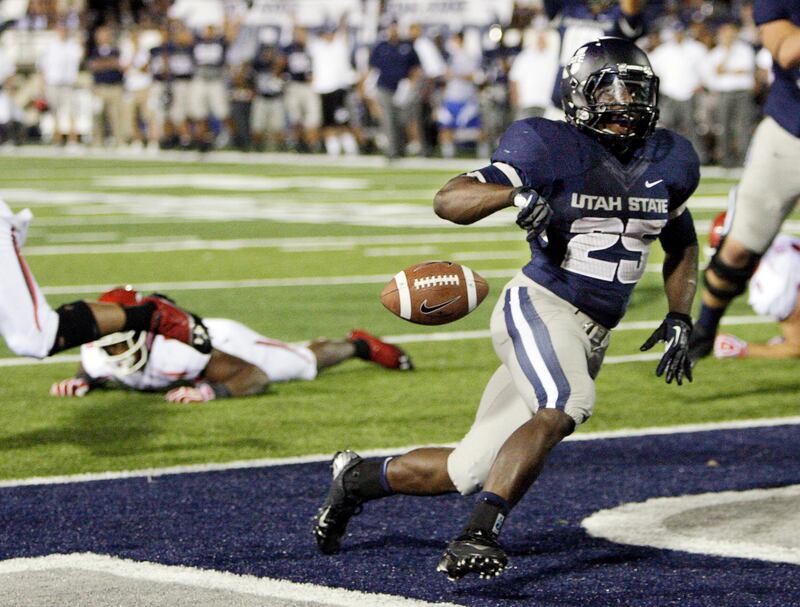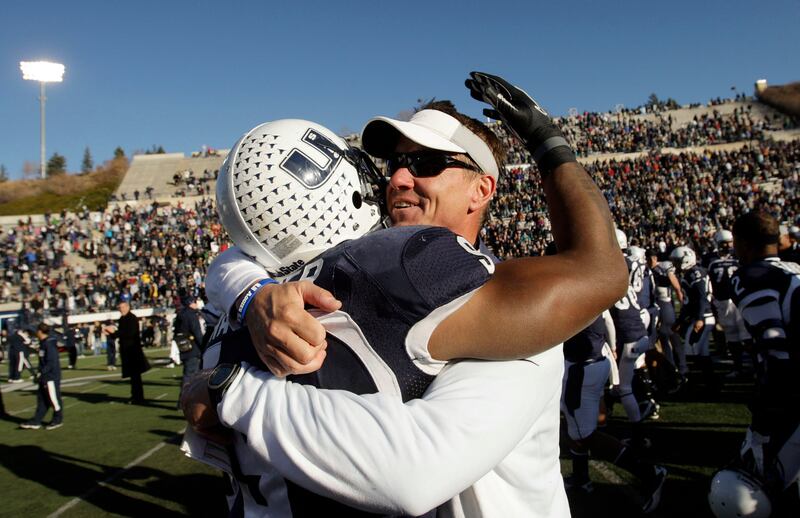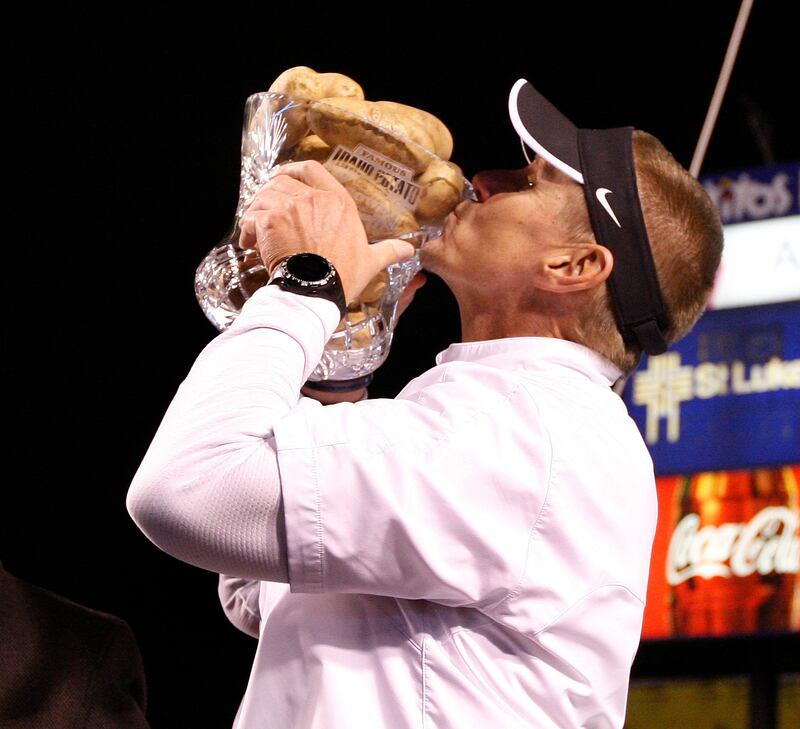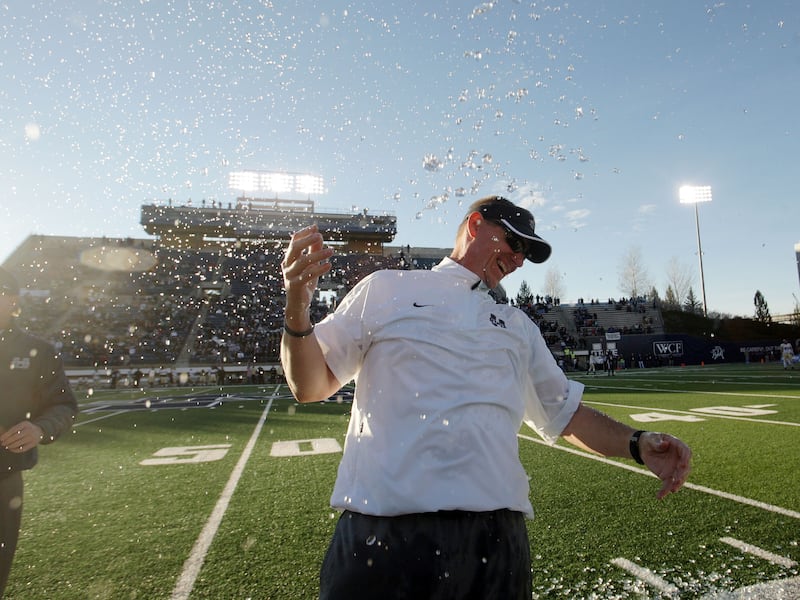The legacy of the Gary Andersen era of Utah State football is destined to be met with mixed emotions — elation over how his first stint kicked off unprecedented success for a long-forlorn program, sadness over how quickly the second stint ended with shaky results.
Andersen led the Aggies for nearly 51⁄2 seasons as head coach — first from 2009-12, then again from December 2018 until he was let go last weekend, three games into the 2020 season. In spite of his unfortunate early exit last week, Andersen ushered in a new era of success in Utah State football.
“I’d like to thank coach A. He has been incredible to us for the last two years. It is unfortunate what happened, but from personal experience coach A has always been good to us and had our best interests at heart,” USU senior defensive lineman Justus Te’i said Monday. “… I’ll always have coach A’s back and he’ll always have ours.”
Here’s a look back at the highs and lows of Andersen’s time in Logan.
First back-to-back winning seasons in over 30 years
Andersen’s first two seasons as Aggie head coach led to a pair of 4-8 records, but Utah State started its turnaround in his third year, when it went 7-6 in 2011. That included a 5-2 record in Western Athletic Conference play, including five straight wins to end the regular season before losing 24-23 to Ohio in the Famous Idaho Potato Bowl.
It was Utah State’s first bowl appearance since 1997, with guys such as future NFL players Bobby Wagner and Robert Turbin leading the way, as well as freshman quarterback Chuckie Keeton.
That 2011 season — which included four one-score losses, one of which was a 42-38 contest at defending champion Auburn when USU held a 10-point lead late — set the tone for 2012, when Utah State would again have a winning record, marking its first back-to-back winning seasons since 1978-79.
A conference championship and top 20 finish in 2012
The 2012 season was easily Andersen’s best as head coach of the Aggies, as Utah State won the WAC for its 12th conference championship in school history (that also serves as the school’s most recent conference title).
An early season victory over in-state rival Utah — a 27-20 overtime thriller — set the tone for that year. Kerwynn Williams scored a 1-yard touchdown in OT, then Will Davis broke up a pass in the end zone on Utah’s possession as the Aggies beat the Utes for the first time since 1997.

From there, Utah State would lose just twice — both close losses to Wisconsin and BYU — while beating two Mountain West Conference teams, Colorado State and UNLV, before rolling through conference play. The Aggies went 6-0 during WAC play, averaging 44.8 points per game in league action.
Utah State capped the year with a dominant 41-15 victory over nine-win Toledo in the Potato Bowl, the Aggies’ first bowl win since 1993. Utah State finished the year ranked No. 16 in The Associated Press poll, the program’s second-best finish in the poll behind the 1961 season, when USU went 9-1-1 and ended the year ranked No. 10.
Frank Maile, who is serving as the Aggies’ interim coach with Andersen’s departure, joined the staff during that era, first as a grad assistant in 2009-10 before becoming the team’s defensive line coach, then later an assistant head coach and co-defensive coordinator.
“If it wasn’t for him, I wouldn’t be sitting in this seat, for a lot of different reasons. He was the one person who gave me a shot at coaching, right out of grad school. I owe a lot to him and will be indebted to him forever. He is a friend, he’s family, he’s one of the biggest mentors I’ve had in coaching. I will always love him and be thankful for him,” Maile said Monday.
Ushering in the MWC era
The year after Andersen’s first stint, the Aggies changed conferences, joining the Mountain West.
The 2012 season was the first double-digit win season in Utah State history — the Aggies would follow that up with a 10-4 year in 2014, and another 11-2 season in 2018. From 2012-14, Utah State won 30 games, the best three-year span in school history, and finished in the top two of the Mountain West’s Mountain Division standings four times under his successor/predecessor Matt Wells.
In the six years away from the program, meanwhile, Andersen spent time as the head coach at Wisconsin and Oregon State, with a year as an assistant at Utah.
A rough return
Andersen returned to coach the Aggies after Wells left to take over as head coach at Texas Tech following the 2018 season. Andersen led Utah State to a 6-2 record in conference play in 2019, his first in the Mountain West. That also included a 7-6 mark overall.
This year, though, Utah State is off to an 0-3 start — the Aggies have been outscored by an average 28 points per game — and Andersen was let go as head coach last Saturday, two days after a 34-9 loss to Nevada. In his second stint as head coach, Andersen went 7-9 and finished 33-33 as the Aggies’ coach. He lost four in a row, and five of his last six, to finish his coaching career at USU.
Mixed results against in-state rivals
Andersen, who spent more than a decade as a Utah assistant and a one-year stint as Southern Utah’s head coach prior to taking over as Utah State’s coach in 2009, went just 2-5 combined against BYU and Utah during his tenures.
Andersen’s Aggies beat BYU 31-16 in 2010, USU’s first victory over the Cougars since 1993. That set up a new, competitive era under Wells, when Utah State went 3-3 against the Cougars, including back-to-back wins in 2017 and 2018, the Aggies’ most success over BYU since the early 1970s. Andersen-led teams also lost to the Cougars in 2009, 2011 and 2012 (a 6-3 loss, one of two one-score losses in that 11-2 season) and a 42-14 defeat last year.
Andersen went 1-1 against Utah, following a loss in 2009 with the 27-20 overtime victory over Utah in 2012 that serves as the Aggies’ last victory over the Power Five program and proved a catalyst in Utah State’s memorable 2012 year.
Pro talent under Andersen
Over his final three seasons of his first stint as Utah State, Andersen had six players selected in the ensuing NFL draft, including six-time All-Pro Wagner, as well as Turbin. Both players won a Super Bowl ring with the Seattle Seahawks, and Wagner has become one of the game’s top middle linebackers.

Those six draft picks during that three-year span (the 2011-13 NFL drafts) equaled the number of draft picks from both Utah and BYU combined during that time.
While he played his first two years under Wells, quarterback Jordan Love, a first-round draft pick by Green Bay earlier this year, spent his final season in Logan under Andersen’s regime.
“They way he did it developing young men, not just on the football field, but in the classroom and preparing them for the game of life, I will be forever indebted to Gary Andersen, as will all of Aggie nation for what he has done,” Utah State athletic director John Hartwell said.
Bowl consistency
One of the crowning achievements of the Andersen era is how his time at Utah State helped establish the Aggies as a postseason regular over the past decade. The program has played in a bowl game eight of the past nine seasons. Prior to that, Utah State had only played in six bowl games.
Andersen went 1-2 as head coach of the Aggies in bowl contests, including the Potato Bowl win in 2012, the Potato Bowl loss in 2011 and a 51-41 loss to Kent State in last year’s Frisco Bowl.

Combined with Wells’ 3-2 mark in bowl games, the Aggies have a 4-4 bowl record since 2011.
“His departure from Utah State should take nothing away from the body of work that Gary Andersen has done for our program,” Hartwell said. “It has been outstanding — obviously pre my tenure at Utah State — but looking back and seeing the way, the positive way in which he flipped our football program from years of mediocrity at best into being an annual bowl participant.”


